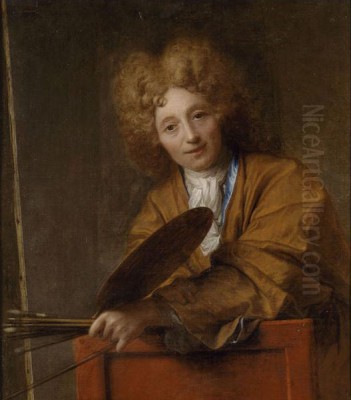
Jean-Baptiste Santerre (1651-1717) stands as a significant yet sometimes overlooked figure in the rich tapestry of French art history. Active during the late reign of Louis XIV and the subsequent Régence period, Santerre navigated the transition from the formal grandeur of the High Baroque to the burgeoning intimacy and elegance of the Rococo. Primarily celebrated as a portraitist, he developed a distinctive style characterized by technical refinement, subtle psychological depth, and a penchant for allegorical nuances. His work, often imbued with a quiet sensuality, includes religious scenes and innovative depictions of the female form, contributing uniquely to the artistic landscape of his time. Furthermore, his initiative in establishing a drawing school for women at Versailles marks him as a figure of note in the history of art education.
Early Life and Artistic Formation in Paris
Born in Magny-en-Vexin, a town northwest of Paris, in 1651, Jean-Baptiste Santerre came from a family of merchants. This background set him apart from many artists who emerged from established artistic dynasties. His initial foray into the world of art began in Paris, where he first studied under the portrait painter François Lemaire. While details of this early apprenticeship are scarce, it likely provided Santerre with the foundational skills in capturing likeness and handling paint necessary for a career in portraiture, a genre that would remain central to his output.
His artistic education took a more significant turn when he entered the studio of Bon Boullogne (also known as Bon Boullogne the Elder). Boullogne was a respected history painter and a prominent member of the Académie Royale de Peinture et de Sculpture. Studying with Boullogne exposed Santerre to the academic tradition, emphasizing drawing from life, studying classical sculpture, and mastering complex compositions. Although Santerre would ultimately focus more on portraiture and genre-like scenes than the grand historical narratives favored by his master, the rigorous training under Boullogne undoubtedly honed his technical prowess and understanding of composition and anatomy.
The Influence of Masters: Troy and Rembrandt
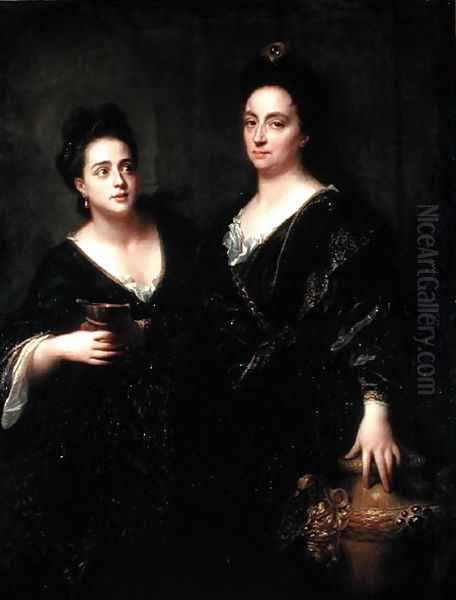
Santerre's artistic development was shaped not only by his direct teachers but also by the prevailing artistic currents and the work of influential masters. One significant contemporary influence was François de Troy, a highly successful portrait painter known for his elegant and flattering depictions of the aristocracy. De Troy's sophisticated style, characterized by rich fabrics, graceful poses, and a certain worldly charm, likely resonated with Santerre and informed his own approach to portraiture, particularly in capturing the refined air sought by his clientele.
Perhaps more intriguing is the acknowledged influence of the Dutch master Rembrandt van Rijn. While seemingly distant in time and place, Rembrandt's profound impact on European art, particularly his mastery of chiaroscuro (the dramatic use of light and shadow) and psychological penetration, was felt across borders. Santerre is noted for absorbing elements of Rembrandt's technique, particularly in his handling of light to create mood and focus attention. This influence might also be seen in Santerre's interest in tronies – character studies or heads depicted with interesting expressions or costumes – a genre Rembrandt excelled at. This blend of French elegance, influenced by de Troy, with the introspection and light effects reminiscent of Rembrandt contributed to the unique character of Santerre's work.
Forging a Unique Style: Portraiture and Allegory
Santerre distinguished himself by developing a highly refined and personal style. His technique was meticulous, often characterized by a smooth, polished finish with barely visible brushstrokes, lending his figures a porcelain-like quality. His colour palette tended towards subtlety and harmony, often employing soft, luminous tones that contributed to the gentle, sometimes melancholic, atmosphere of his paintings. He excelled in rendering textures, particularly the softness of skin and the sheen of fabrics like satin and velvet.
A key aspect of Santerre's art was his fusion of straightforward portraiture with allegorical or genre elements, sometimes blurring the lines between reality and imagination. This approach aligns with the tradition of the portrait historié, where sitters were depicted in the guise of mythological or historical figures, but Santerre often employed subtler, more enigmatic allusions. His figures frequently possess a quiet, introspective quality, inviting contemplation rather than proclaiming status with overt grandeur, setting him apart from the more formal state portraiture exemplified by contemporaries like Hyacinthe Rigaud.
Masterworks: Defining Santerre's Oeuvre
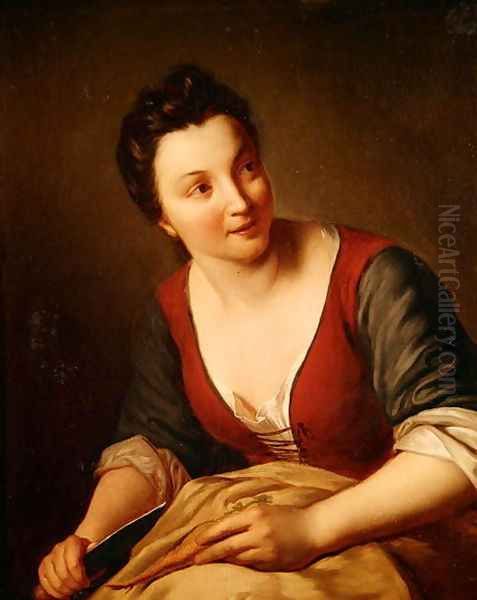
Santerre's reputation rests on a select number of key works that encapsulate his style and thematic concerns. Among his most celebrated paintings is Susanna at her Bath (1704), now housed in the Louvre Museum. Depicting the biblical story of Susanna spied upon by the elders, Santerre's interpretation eschews overt drama for a moment of quiet vulnerability and refined sensuality. Susanna is presented with delicate realism, her form illuminated against a darker background, showcasing Santerre's skill in rendering flesh tones and his subtle use of light. The painting is considered a masterpiece of early Rococo sensibility, balancing religious narrative with an appreciation for graceful form and intimate mood.
Another iconic work is the Portrait of a Young Woman with a Veil (sometimes titled Girl with a Veil), dating from around 1699 and held in the Hermitage Museum, St. Petersburg. This captivating image presents a young woman, her face partially obscured by a translucent veil, gazing enigmatically towards the viewer. The ambiguity of her expression and the delicate handling of the veil create an aura of mystery and subtle allure. It exemplifies Santerre's ability to imbue a simple format with psychological intrigue and showcases his refined technique.
Also in the Hermitage is the Portrait of Two Actresses (1699). This double portrait captures the subjects in a moment of apparent intimacy and shared confidence. The composition is balanced, and the characterization suggests individual personalities while linking them through pose and gaze. Like many of his works, it demonstrates Santerre's skill in creating portraits that feel both elegant and engagingly human.
Other notable works held in the Louvre further illustrate his range, including the Portrait of a Lady in Venetian Dress, Young Woman in a Hooded Cloak, The Cook (a rare foray into genre), The Duc d'Orléans and Madame de Parabère, and the Portrait of the Comtesse de Beuvron. His drawings, such as the Study of Hands Holding a Mask and a Ticket (c. 1700), reveal his careful preparatory methods and skill in capturing gesture and detail.
Patronage, the Academy, and Royal Recognition
Santerre's refined style found favour among aristocratic patrons, including members of the royal family and the court circle. His ability to combine likeness with an air of elegance and sensitivity appealed to the tastes of the era. His patrons included Philippe II, Duke of Orléans, who served as Regent of France after the death of Louis XIV. Santerre painted the Duke alongside his mistress, Madame de Parabère, demonstrating his access to the highest echelons of society.
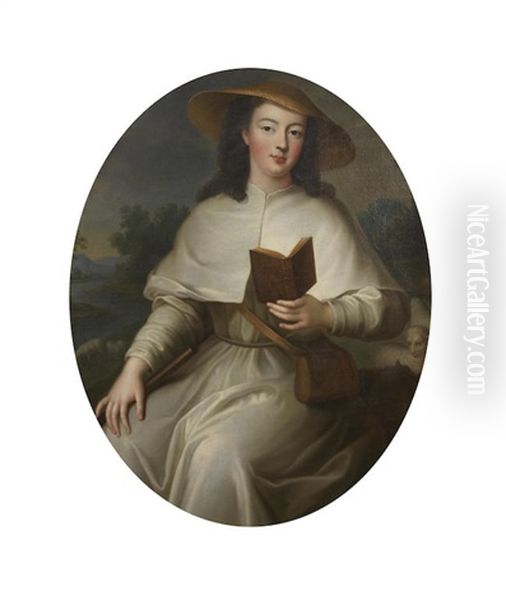
A significant milestone in his career was his acceptance into the prestigious Académie Royale de Peinture et de Sculpture in 1704. Membership in the Academy was the primary path to official recognition and major commissions in France. Santerre was received as a history painter, likely based on works like his Susanna at her Bath, although portraiture remained his main focus. His reception piece for the Academy was reportedly a depiction of Mary Magdalene Penitent.
His standing was further confirmed by commissions for King Louis XIV himself, undertaken at the Palace of Versailles. While specific details of all his royal commissions are not fully documented, works like Susanna at her Bath were acquired for the royal collection, indicating the King's approval. He is also known to have painted portraits of figures connected to the court, such as Adelaide d'Orléans. Working at Versailles placed Santerre at the very centre of French artistic and political life during the final years of the Sun King's reign.
An Innovative Educator: The Versailles School for Women
Beyond his own artistic production, Jean-Baptiste Santerre made a notable contribution to art education, particularly for women. He established and directed a drawing school specifically for women, located within the Palace of Versailles itself. This initiative was quite remarkable for its time. While women were not entirely excluded from the arts, their opportunities for formal training were severely limited compared to men. The main Académie Royale admitted very few women members throughout its history, and access to life drawing classes, considered essential for history painting, was generally barred to them.
Santerre's school, therefore, provided a rare and valuable venue for women at court or connected to it to receive instruction in drawing. The curriculum likely focused on drawing from casts, prints, and perhaps still life or draped models, aligning with the types of subjects considered appropriate for female artists at the time. While the full extent of the school's influence is difficult to gauge, its very existence under Santerre's direction within the royal palace was a significant, albeit modest, step towards acknowledging and fostering female artistic talent. It reflects a progressive aspect of Santerre's career, setting him apart from many contemporaries.
Santerre in the Context of His Contemporaries
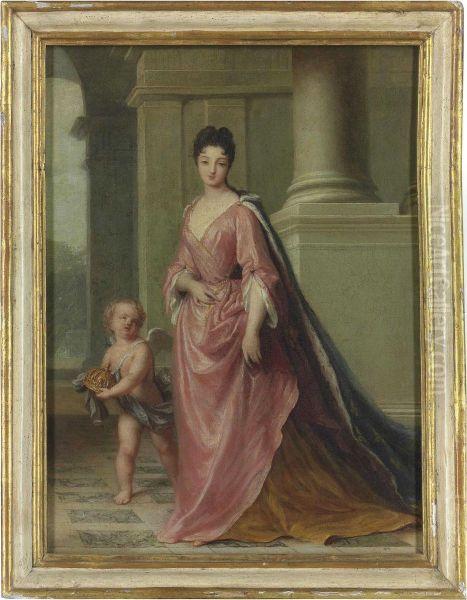
To fully appreciate Santerre's position, it is essential to view him alongside the other prominent artists of his time. The late 17th and early 18th centuries in France were dominated by towering figures in portraiture and history painting. In portraiture, Hyacinthe Rigaud and Nicolas de Largillière reigned supreme. Rigaud was the master of the grand state portrait, known for his imposing depictions of Louis XIV and the nobility, emphasizing power and status through elaborate costumes and settings. Largillière offered a slightly different, often warmer style, excelling in rich textures and vibrant colours, popular among the wealthy bourgeoisie as well as the aristocracy.
Compared to Rigaud's formality and Largillière's opulence, Santerre offered a more intimate and psychologically nuanced approach. His portraits often feel quieter, more introspective, focusing on subtle expression and mood rather than overt displays of rank. While technically accomplished, his work generally avoids the sheer bravura and scale often seen in the works of his two main rivals in the field.
In history painting, the academic tradition was upheld by artists like Charles de La Fosse, Jean Jouvenet, Antoine Coypel, and Santerre's own teacher, Bon Boullogne, along with Bon's brother, Louis de Boullogne the Younger. These artists produced large-scale religious, mythological, and historical canvases for churches and royal palaces, adhering to the principles taught at the Academy. While Santerre was received into the Academy as a history painter and produced works like Susanna, his output in this genre was less extensive than that of the leading specialists. His strength lay in adapting historical or biblical themes to a more intimate, often sensual, scale and mood.
Perhaps the most significant contemporary in terms of stylistic evolution was Antoine Watteau. Although slightly younger, Watteau's career overlapped with Santerre's later years. Watteau became the quintessential painter of the Rococo fête galante, depicting elegant figures in parkland settings, imbued with poetry, melancholy, and theatricality. While their subject matter differed – Watteau rarely painted formal portraits or nudes in Santerre's manner – both artists shared a sensitivity to delicate colour harmonies, graceful forms, and nuanced emotional states that heralded the shift towards the Rococo aesthetic. Santerre can be seen as working in parallel, exploring intimacy and refinement primarily through the lens of portraiture and the single figure study.
Influence and Lasting Legacy

Jean-Baptiste Santerre's influence extended into the subsequent generation of Rococo artists. His refined sensuality, delicate colour palette, and smooth technique found echoes in the works of François Boucher and Jean-Honoré Fragonard, the leading masters of the high Rococo. Boucher, known for his mythological scenes and decorative paintings, often depicted female figures with a similar porcelain-like skin finish and graceful charm, albeit usually with a more overt and playful eroticism than Santerre. Fragonard, particularly in his more intimate genre scenes and portraits, captured a similar blend of sensitivity and subtle allure.
Santerre's contribution lies in his role as a transitional figure. He successfully navigated the shift from the late Baroque's emphasis on grandeur and formality towards the Rococo's preference for intimacy, elegance, and nuanced emotion. He adapted the technical polish of the academic tradition to subjects that were often more personal and psychologically engaging. His willingness to explore the female nude with a refined sensibility, distinct from both the heroic nudes of the High Baroque and the more explicit depictions that would follow, marked a particular contribution.
His work in portraiture offered an alternative to the dominant styles of Rigaud and Largillière, emphasizing subtlety and introspection. Furthermore, his establishment of the women's drawing school at Versailles, however limited its scope might seem today, remains a noteworthy aspect of his career, highlighting an engagement with art education beyond his own studio practice.
Critical Reception and Conclusion
Historically, Jean-Baptiste Santerre has perhaps been overshadowed by the giants of his own time, like Rigaud and Largillière, and the subsequent stars of the Rococo, like Watteau, Boucher, and Fragonard. Some critics, particularly in later periods that reacted against the Rococo, may have found his work lacking in grandeur or moral seriousness. His focus on refinement and subtle sensuality could be interpreted as lacking the dramatic force of the Baroque or the intellectual weight of Neoclassicism.
However, contemporary and modern art historians recognize Santerre's distinct contribution to French painting. He is appreciated for his exquisite technique, his ability to capture subtle moods, and his role in developing the visual language of the early Rococo. Works like Susanna at her Bath and Young Woman with a Veil are acknowledged as masterpieces of their kind, admired for their beauty, sensitivity, and technical perfection. His synthesis of French and Northern European influences, particularly the subtle incorporation of Rembrandtesque light and mood, is seen as a sophisticated aspect of his art.
In conclusion, Jean-Baptiste Santerre occupies a unique and important place in French art history. As a master portraitist, he offered a refined and intimate alternative to the prevailing modes of his time. As an interpreter of religious and allegorical themes, he infused traditional subjects with a modern sensibility, emphasizing grace and subtle emotion. His technical skill was exceptional, resulting in works of captivating beauty and polish. Bridging the gap between the age of Louis XIV and the rise of the Rococo, and contributing to the education of women artists, Santerre remains a figure worthy of study and admiration, a painter whose quiet elegance continues to resonate.